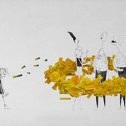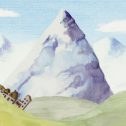"Christmas 1916, a French soldier is sent to the front line to investigate an object falling from the sky into no man’s land."
From Above is a short film created by a team of artists at French school ArtFX about an unexpected truce that takes place on Christmas Eve during World War 1.
The script is based on a true event, which is known as The Christmas Truce: it refers to a number of spontaneous ceasefires that happened during World War 1, around Christmas 1914. The armistice turned into singing of Christmas songs as soldiers from Britain and Germany met in no man’s land (the unoccupied area located between the two armies) exchanging presents and playing football. The event inspired popular songs such as Paul McCartney’s Pipes of Peace and The Farm’s All Together Now.
From Above personifies this Christmas spirit that helped bring about the ceasefires in an explicit way. The film presents three main characters, external conflicts as well as conflicts with the environment, non-realistic staging, an emphasis on offscreen space and a combination of war and Christmas genres.
The short is situated in 1916 in eastern France on Christmas Eve during World War 1, and uses a stylized, painterly aesthetic, with impressive effort dedicated to framing, composition of elements, colors, lighting, etc. The production is highly polished and a pleasure to watch, clearly showing the result of the number of artists that worked on it (seven students producing and directing the film plus three specialists for rigging, animation and FX). Environments, set dressing and character designs are also worth noting.
From Above features some very effective sequences and cinematography, with great use of sensory images (bottles hitting each other at 0.32s, unsettling blinking lights starting at 1.21, turning gear at 3.35, etc.), as well as a tense sequence of a soldier exploring the town at night, with great use of offscreen space and a semi-subjective camera to create suspense. This leads to a quick pan that stops abruptly in 1.53, amplified by sound, then increasing the emotive level with a close-up.
The short employs medium, full and long shots to portray the performance of the French soldier. Wider shots are used to describe the environments, as well as two or three-shots to capture the characters together and transmit the idea of collaboration. Close-ups are used sparingly and effectively to transmit emotion or detailed actions of the characters. Framing becomes tighter during the soldier’s night exploration sequence, with handheld moving cameras that help transmit dynamism and the emotional displacement of the soldier. Camera moves are also used in reveal shots (2.18, 4.03).
Visual rhythm is usually high and varies according to dramatic tension. It’s implemented through editing, motion within the frame, camera moves (pans, tilts, zooms, dollies, handheld cameras, etc.), camera shakes, changes in lighting, etc.
What makes the short work so well? Great script that departs from the contemporary and is inspired by a remarkable event from history, abundant surprises, highly polished aesthetic work, effective directing that raises tension, strong external conflict and an unexpected shift from the war to the Christmas genre that veers the film to the fantasy realm and offers a healthy message of collaboration and hope.
Antoine Thiaucourt's site
Arthur Damiano's site
Hector Dao's site
Julien Jousse's site
Léonard Haug's site
Nathan Baussois's site
Vincent Hebrard's site
Link
Link



















Très beau film au message fort. Surtout en ces temps troublés.